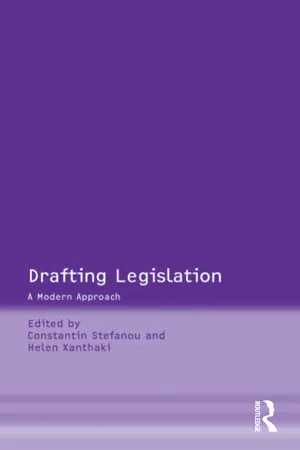
Drafting Legislation
A Modern Approach
- 352 pages
- English
- ePUB (mobile friendly)
- Available on iOS & Android
Drafting Legislation
A Modern Approach
About This Book
Drafting Legislation sets out to prove Sir William Dale's doctrine that the rules for drafting good quality legislation are the same in common and civil systems of law. Legislative solutions can therefore serve the drafter, the judge and the practitioner of any jurisdiction. The book discusses the general issue of quality in legislation from the legislative process to the actual drafting interpretation and enforcement. It also analyzes topics related to quality in legislation such as clarity, precision and disambiguity, plain language and gender-neutral language and assesses whether Sir William's view of universality in the definition and elements of quality in legislation is right or not. The volume is of critical interest to students and scholars of European law and the philosophy and theory of law.
Frequently asked questions
1 On Transferability of Legislative Solutions: The Functionality Test
Transferability in Legislative Drafting
Functionality
Table of contents
- Cover Page
- Half Title Page
- Title Page
- Copyright Page
- Table of Contents
- List of Figures
- List of Contributors
- 1 On Transferability of Legislative Solutions: The Functionality Test Helen Xanthaki
- 2 Drawing the Line Stephen Laws CB
- 3 Legislative Intention Ian McLeod
- 4 Legislator’s Intent: How Judges Discern it and What They Do if They Find it Justice Keith Mason
- 5 The Techniques of Gender-neutral Drafting Daniel Greenberg
- 6 Drafting Legislation at the Tax Law Rewrite Project Hayley Rogers
- 7 Retrospectivity in the Drafting and Interpretation of Legislation Lydia Clapinska
- 8 Repealing or Amending Legislation by Non-Legislative Means Alec Samuels
- 9 Pre-legislative Scrutiny Zione Ntaba
- 10 The Role of the Legislative Drafter in Promoting Social Transformation Richard C. Nzerem
- 11 Improving Democratic Development by Better Regulation Ulrich Karpen
- 12 Drafting Principles of Existing European Contract Law Gerhard Dannemann
- 13 Drafting of EU Acts: A View From the European Commission William Robinson
- 14 Drafting to Implement EU Law: the European Arrest Warrant in the United Kingdom Valsamis Mitsilegas
- 15 Procedures for the Approximation of Albanian Legislation with the Acquis Communautaire Alfred E. Kellermann
- 16 Compromise and Clarity in International Drafting Eileen Denza
- 17 Can Legislation Rank As Literature? Helen Caldwell
- 18 Open Management of Legislative Documents Giovanni Sartor
- 19 Between Policy and Implementation: Legislative Drafting for Development Ann Seidman and Robert B. Seidman
- 20 Drafters, Drafting and the Policy Process Constantin Stefanou
- Index